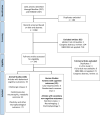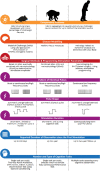Electrical stimulation of the nucleus basalis of meynert: a systematic review of preclinical and clinical data
- PMID: 34083732
- PMCID: PMC8175342
- DOI: 10.1038/s41598-021-91391-0
Electrical stimulation of the nucleus basalis of meynert: a systematic review of preclinical and clinical data
Abstract
Deep brain stimulation (DBS) of the nucleus basalis of Meynert (NBM) has been clinically investigated in Alzheimer's disease (AD) and Lewy body dementia (LBD). However, the clinical effects are highly variable, which questions the suggested basic principles underlying these clinical trials. Therefore, preclinical and clinical data on the design of NBM stimulation experiments and its effects on behavioral and neurophysiological aspects are systematically reviewed here. Animal studies have shown that electrical stimulation of the NBM enhanced cognition, increased the release of acetylcholine, enhanced cerebral blood flow, released several neuroprotective factors, and facilitates plasticity of cortical and subcortical receptive fields. However, the translation of these outcomes to current clinical practice is hampered by the fact that mainly animals with an intact NBM were used, whereas most animals were stimulated unilaterally, with different stimulation paradigms for only restricted timeframes. Future animal research has to refine the NBM stimulation methods, using partially lesioned NBM nuclei, to better resemble the clinical situation in AD, and LBD. More preclinical data on the effect of stimulation of lesioned NBM should be present, before DBS of the NBM in human is explored further.
Conflict of interest statement
T.v.L. has received research support from the Weston Brain Institute, speaker fees from Britannia, AbbVie and Medtronic, and is on the advisory boards of LTI and Neuroderm. M.N. and I.H.C.H.M.P. declare no potential conflict of interest.
Figures



Similar articles
-
Deep Brain Stimulation in Alzheimer's Disease: Targeting the Nucleus Basalis of Meynert.J Alzheimers Dis. 2021;80(1):53-70. doi: 10.3233/JAD-201141. J Alzheimers Dis. 2021. PMID: 33492288 Review.
-
Stimulate or degenerate: deep brain stimulation of the nucleus basalis Meynert in Alzheimer dementia.World Neurosurg. 2013 Sep-Oct;80(3-4):S27.e35-43. doi: 10.1016/j.wneu.2012.12.005. Epub 2012 Dec 12. World Neurosurg. 2013. PMID: 23246738 Review.
-
Nucleus Basalis of Meynert Stimulation for Lewy Body Dementia: A Phase I Randomized Clinical Trial.Neurology. 2021 Feb 2;96(5):e684-e697. doi: 10.1212/WNL.0000000000011227. Epub 2020 Nov 16. Neurology. 2021. PMID: 33199437 Free PMC article. Clinical Trial.
-
Nucleus basalis of Meynert modulates signal processing in rat layer 5 somatosensory cortex but leads to memory impairment and tactile discrimination deficits following lesion.Behav Brain Res. 2020 May 27;386:112608. doi: 10.1016/j.bbr.2020.112608. Epub 2020 Mar 16. Behav Brain Res. 2020. PMID: 32194192
-
The neuroprotective effect of deep brain stimulation at nucleus basalis of Meynert in transgenic mice with Alzheimer's disease.Brain Stimul. 2019 Jan-Feb;12(1):161-174. doi: 10.1016/j.brs.2018.08.015. Epub 2018 Aug 27. Brain Stimul. 2019. PMID: 30181106
Cited by
-
Modulation of the rat hippocampal-cortex network and episodic-like memory performance following entorhinal cortex stimulation.CNS Neurosci Ther. 2022 Mar;28(3):448-457. doi: 10.1111/cns.13795. Epub 2021 Dec 28. CNS Neurosci Ther. 2022. PMID: 34964261 Free PMC article.
-
Modulating the cholinergic system-Novel targets for deep brain stimulation in Parkinson's disease.J Neurochem. 2025 Feb;169(2):e16264. doi: 10.1111/jnc.16264. Epub 2024 Nov 18. J Neurochem. 2025. PMID: 39556446 Free PMC article. Review.
-
Rhythmicity of Prefrontal Local Field Potentials after Nucleus Basalis Stimulation.eNeuro. 2022 Feb 3;9(1):ENEURO.0380-21.2022. doi: 10.1523/ENEURO.0380-21.2022. Print 2022 Jan-Feb. eNeuro. 2022. PMID: 35058309 Free PMC article.
-
Advances in DBS Technology and Novel Applications: Focus on Movement Disorders.Curr Neurol Neurosci Rep. 2022 Sep;22(9):577-588. doi: 10.1007/s11910-022-01221-7. Epub 2022 Jul 15. Curr Neurol Neurosci Rep. 2022. PMID: 35838898 Review.
-
Deep brain stimulation of the nucleus basalis of Meynert modulates hippocampal-frontoparietal networks in patients with advanced Alzheimer's disease.Transl Neurodegener. 2022 Dec 5;11(1):51. doi: 10.1186/s40035-022-00327-9. Transl Neurodegener. 2022. PMID: 36471370 Free PMC article.
References
Publication types
MeSH terms
Substances
LinkOut - more resources
Full Text Sources

